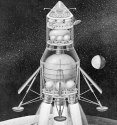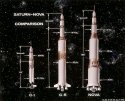Will there be another Chang'e 5 like mission before a manned landing on the moon?
You are using an out of date browser. It may not display this or other websites correctly.
You should upgrade or use an alternative browser.
You should upgrade or use an alternative browser.
China's Space Program News Thread
- Thread starter crazyinsane105
- Start date
- Status
- Not open for further replies.
China’s space ambitions: Robot on Mars, a human on the moon
Some clippings
China’s landing of its third probe on the moon is part of an increasingly ambitious space program that has a robot rover en route to Mars, is developing a reusable space plane and is planning to put humans back on the lunar surface.
China has proceeded more cautiously than the breakneck U.S.-Soviet space race of the 1960s, which was marked by fatalities. China’s crewed missions have gone ahead without incident. Some launches of robot vehicles have been delayed by technical problems but those appear to have been resolved.
While Chang’e 5 gathers moon rocks, Japan’s space agency just pulled off the even more challenging feat of obtaining samples from an asteroid, Ryugu. The Hayabusa2 mission is due to deliver those to Earth on Saturday.
It has joined the race to explore Mars, and its Tianwen-1 probe, launched in July carrying a robot rover to search for signs of water, is due to complete its 470-million kilometer (292-million mile) journey in February.
The agency announced in September its space plane had completed a successful test flight but has yet to release details or even a photo of the craft.
Some clippings
China’s landing of its third probe on the moon is part of an increasingly ambitious space program that has a robot rover en route to Mars, is developing a reusable space plane and is planning to put humans back on the lunar surface.
China has proceeded more cautiously than the breakneck U.S.-Soviet space race of the 1960s, which was marked by fatalities. China’s crewed missions have gone ahead without incident. Some launches of robot vehicles have been delayed by technical problems but those appear to have been resolved.
While Chang’e 5 gathers moon rocks, Japan’s space agency just pulled off the even more challenging feat of obtaining samples from an asteroid, Ryugu. The Hayabusa2 mission is due to deliver those to Earth on Saturday.
It has joined the race to explore Mars, and its Tianwen-1 probe, launched in July carrying a robot rover to search for signs of water, is due to complete its 470-million kilometer (292-million mile) journey in February.
The agency announced in September its space plane had completed a successful test flight but has yet to release details or even a photo of the craft.
Hmm I heard about China's new reusable rockets, what about this reusable space plane that is so secretive?
China’s space ambitions: Robot on Mars, a human on the moon
Some clippings
China’s landing of its third probe on the moon is part of an increasingly ambitious space program that has a robot rover en route to Mars, is developing a reusable space plane and is planning to put humans back on the lunar surface.
China has proceeded more cautiously than the breakneck U.S.-Soviet space race of the 1960s, which was marked by fatalities. China’s crewed missions have gone ahead without incident. Some launches of robot vehicles have been delayed by technical problems but those appear to have been resolved.
While Chang’e 5 gathers moon rocks, Japan’s space agency just pulled off the even more challenging feat of obtaining samples from an asteroid, Ryugu. The Hayabusa2 mission is due to deliver those to Earth on Saturday.
It has joined the race to explore Mars, and its Tianwen-1 probe, launched in July carrying a robot rover to search for signs of water, is due to complete its 470-million kilometer (292-million mile) journey in February.
The agency announced in September its space plane had completed a successful test flight but has yet to release details or even a photo of the craft.
The article is just too poorly researched to worth commenting on.
The article is just too poorly researched to worth commenting on.
The details were certainly not extensive, but I included it because it was useful in recapping events so far.
AssassinsMace
Lieutenant General
From what I've read of the difference between the American, Russian, and Chinese missions was the US had astronauts retrieve samples. The Russian one was automated and with a direct from the moon to earth return vehicle but that could only be done from certain parts of the moon. The Chinese one was automated also but the sample is shot up to orbit where it will dock with the return vehicle to go back to earth. That could be done from any part of the moon.
The Russian Luna sample return missions used a simpler direct ascent profile to return to earth, partly due to this the amount of sample they could return was vastly smaller than Chang'e 5. In addition Luna's ascent stage had a KRD-61 engine which could only be lit once and could not be throttled, so it must complete both the ascent back to lunar orbit as well as the injection back to earth in a single burn. This means the landing must take place at a precise location on the moon. If the craft missed its landing spot it may not be able to return to earth because orbital parameters may not allow a single burn of the engine to complete both ascent and ejection.From what I've read of the difference between the American, Russian, and Chinese missions was the US had astronauts retrieve samples. The Russian one was automated and with a direct from the moon to earth return vehicle but that could only be done from certain parts of the moon. The Chinese one was automated also but the sample is shot up to orbit where it will dock with the return vehicle to go back to earth. That could be done from any part of the moon.
Luna 16 - 5.7 tons at launch, returned 101g of lunar sample
Chang'e 5 - 8.2 tons at launch, will return 2kg of lunar sample
As you can see, lunar orbit rendezvous mission profile enormously boost the amount of sample that could be returned for a given mass of the spacecraft. This is also why it was chosen for Apollo - lunar orbit rendezvous meant the stack could be launched on a Saturn V sized rocket, while a direct ascent version of Apollo would have required a much bigger rocket called "Nova".
A direct ascent version of Apollo spacecraft during landing:

As you can see it would have been quite the monster, and this is how big the rocket underneath it would have been:

Last edited:
The most critical and groundbreaking part of Chang e 5 mission is about to begin in 40 minutes.
Firing of direct ascent vehicle...I am sure we will get absolutely zero coverage on this one
Firing of direct ascent vehicle...I am sure we will get absolutely zero coverage on this one
Ascent module liftoff
- Status
- Not open for further replies.
